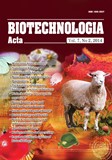ISSN 2410-7751 (Print)
ISSN 2410-776X (Online)

"Biotechnologia Acta" v. 7, no 2, 2014
https://doi.org/10.15407/biotech7.02.070
Р. 70-78, Bibliography 19, Russian.
Universal Decimal classification: 544.7+577.1:617.735-007.281-089
А. M. Ruban 1, A. I. Kazanets 1, T. V. Krupskaya 2, V. V. Turov 2
1 Сlinical eye hospital «Eye microsurgery center», Kyiv, Ukraine
2 Chuiko Institute of Surface Chemistry of the National Academy of Sciences of Ukraine, Kyiv
To create a biologically inert material suitable for use in a wide range of temperatures and in corrosive environments, the methods of optical microscopy and NMR-cryometry were used for investigation of emulsification of solutions of human serum albumin and hyaluronic acid in polymethylsiloxane PDMS-1000. Unlike hyaluronic acid, human serum albumin forms persistent emulsions in the silicon matrix, whose size of the droplets varies from 100 to 10 000 nm. The presence of dispersed phase (human serum albumin or hyaluronic acid) increases significantly melting temperature of polydimethylsiloxane. It is probably due to ordering influence of micro- and nanodrops of biopolymers on PDMS crystals localized between them.
In case of dispersion of hyaluronic acid solution in liquid silicone only microdroplets of the aqueous phase are observed and nanosized droplets either didn’t form or were in amount not sufficient to be detected by NMR cryometry.
The possibility of a significant influence of human serum albumin emulsified solution on PDMS-1000 defrosting temperature is revealed, that is impacted on its optical parameters. This effect is recorded both in the low temperature region and at temperature close to human body, which might influence on silicone state when it is used as implant.
Key words: 1Н NMR-spectroscopy, silicone, human serum albumin, hyaluronic acid, water clusters.
© Palladin Institute of Biochemistry of the National Academy of Sciences of Ukraine, 2014
References
1. Unger K. K. Porous silica: its properties and use in column liquid chromatography. Amsterdam: Elsevier. 1979, 336 p.
2. Jesinowski T., Krysztafkewicz A. Preparation of the hydrophilic/hydrophobic silica particles. Colloid Surface A: Phys. Chem Engin. Aspects. 2002, V. 207, P. 49–58.
https://doi.org/10.1016/S0927-7757(02)00137-1
3. Medical Chemistry and clinical applications of silica dioxide. A. A. Chuiko ed. Кyiv: Naukova dumka. 2003, 415 p.(In Russian)
4. Castellarin A, Grigorian R., Bhagat N., Priore L. D., Zarbin M. A. Vitrectomy with silicone oil infusion in severe diabetic retinopathy. Br. J. Ophthalmol. 2003, V. 87, P. 318–321.
https://doi.org/10.1136/bjo.87.3.318
5. Kirchhof B., Tavakolian U., Paulmann H., Heimann K. Histopathological findings in eyes after silicone oil injection. Graefes Arch. Clin. Exp. Ophthalmol. 1986, V. 224, P. 34–37.
https://doi.org/10.1007/BF02144130
6. Strange J. H., Rahman M., Smith E. G. Characterization of porous solids by NMR. Phys. Rev. Lett. 1993, V. 71, P. 3589–3591.
https://doi.org/10.1103/PhysRevLett.71.3589
7. Strange J. H., Allen S. G., Stephenson P. C. L., Matveeva N. P. Phase equilibria of absorbed liquids and the structure of porous media. Magn. Reson. Imag. 1996, V. 14, P. 963–965.
http://dx.doi.org/10.1016/S0730-725X(96)00196-8
8. Strange J. H., Mitchell J., Webber J. B. W. Pore surface exploration by NMR. Magn. Reson. Imag. 2003, V. 21, P. 221–226.
https://doi.org/10.1016/S0730-725X(03)00128-0
9. Aksnes D. W., Kimtys L. H and H NMR studies of benzene confined in porous solids: melting point depression and pore size distribution. Solid State Nucl. Magn. Reson. 2004, V. 25, P. 146–152.
https://doi.org/10.1016/j.ssnmr.2003.03.001
10. Khokhlov A. G., Valiullin R. P., Stepovich M. A., K?rger J. NMR crioporometry and adsorption methods for characterization of pore size distribution in porous silica. Kolloidnyj zh. 2008, 70(4), 550–557. (In Russian).
11. Petrov O. V. Furo I. NMR cryoporometry: Principles, application and potential. Progr. NMR. 2009, V. 54, P. 97–122.
https://doi.org/10.1016/j.pnmrs.2008.06.001
12. Gunko V. М., Turov V. V., GorbikP.P. Water at the interfaces. Кyiv: Naukova dumka. 2009, 694 p. (In Russian).
13. Turov V. V., Gunko V. M. Clastered water and ways of its applications. Кyiv: Naukova dumka. 2011, 313 p. (In Russian).
14. Gunko V. M., Turov V. V., Bogatyrev V. M., Zarko V. I., Leboda R., Goncharuk E. V., Novza A. A., Turov A. V., Chuiko A. A. Unusual properties of water at hydrophilic/hydrophobic Interfaces. Adv. Colloid. Interf. Sci. 2005, V. 118, P. 125–172.
https://doi.org/10.1016/j.cis.2005.07.003
15. Pople J. A., Schneider W. G., Bernstein H. J. HighResolution Nuclear Magnetic Resonance. New York: McGrawHill Book Company. 1959. Р. 165–180.
16. Turov V. V., Rugal A. O., Gunko V. M. Supramolecular structures with participants of blood polypeptides and highly dispersed silica particles. Chem. Phys. and Technol. of Surface. 2007, V. 2, P. 357–391. (In Russian).
17. Turov V. V., Galagan N. P. Rugal A. P. Sugars influence on serum albumin hydration at low temperatures. Biophysics. 2007, 52(5), 780–784. (In Russian).
18. Ruban А. M., Kazanets А. І., Krupska Т. V., Turov V. V. Interphase interaction of vitreoretynalic silicone with a solution of hyaluronic acid. Med. Chem. 2012, V. 14, P. 44–47. (In Ukrainian).
19. Tertykh V. A., Belyakova L. A. Chemical reactions with silica surface participant. Кyiv: Nauk. dumka, 1991, 246 p. (In Russian).

